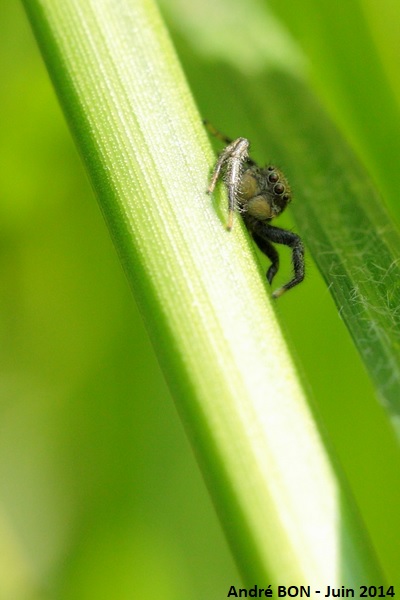
| Marpissa radiata (Grube, 1859) |

|
|
Scientific name: Marpissa radiata (Grube, 1859) Common name: French name: Order: Araneae Family: Salticidae Size: Females: 6 to 9.3 mm; Males: 6 to 7 mm. Biotope: Damp habitats, mainly on Cattails (Typha genus) growing on the banks of stagnant water near lakes, ponds or ditches. Web: No web. Observation period: All year round. Geographic area: Europe but missing in the Iberian Peninsula, Asia east to Siberia. |
Marpissa radiata is a jumping spider with a rather lengthy but not flattened body shape. Females are a general yellowish grey-brown to orange colour. The abdomen bears two longitudinal black or dark brown markings, sometimes thinly externally outlined with reddish, located on both side of a yellow to orange median band. The cephalothorax is dark brown with sparse pale brown hairs. The eyes are circled with dark red and they are located above a broad pale yellow band. The legs are dark brown with sparse pale brown hairs. The tarsi's tip is black. The pedipalps bears long yellowish white hairs. Males are more slender and show a pale brown abdomen marked by three reddish orange longitudinal stripes. The cephalothorax is dark brown to black with a pale brown pattern surrounding, among others, one curved black marking between the posterior lateral eyes. The legs are pale brown with black longitudinal markings. The tarsi are pale brown with black tips. The pedipalps are very big. You can recognize Marpissa pomatia, which is rarer species and rather found among low vegetation in damp open forests and damp meadows, with two pale yellow triangular markings located at the back of the cephalothorax. The abdomen shows rust-coloured longitudinal stripes and males' pedipalps are bigger than on Marpissa radiata. |
| [To know more about the Marpissa radiata] [Top] |

|
I still have many difficulties to shoot pictures of jumping spiders found among vegetation. The high mobility of these small spiders and their tiny size are big problems for me. I have played hide-and-seek with this Marpissa radiata till it drops to the ground where I have not been able to see it again. Here is the only picture I have got and this is an important crop. The large pedipalps are one particularity of males of this species. |